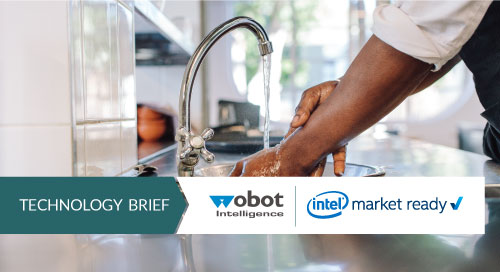Computer Vision Puts a Focus on Hygiene

The new normal includes a hyper-focus on hygiene and safety, for consumers and businesses alike. But the problem of ensuring that employees do what standard operating procedure (SOP) dictates, and in a way that doesn’t drag on company resources, isn’t new at all.
Unfortunately, the default solution relies mostly on human resources to manage quality control. For example, restaurants concerned about kitchen hygiene, or retailers that prioritize prompt service? Typically, monitoring compliance involves time-consuming processes like a post hoc review of CCTV feeds.
This approach is expensive and slow. But maybe even more troubling, it doesn’t always work. “The human eye can only take in 22 minutes of stimuli before concentration is lost, so imagine what gets missed when people are asked to review hours of CCTV footage,” says Adit Chhabra, co-founder, and CEO of Wobot. “A person doing random checks might work better, but what happens when no one’s watching?”
Automation and real-time feedback are emerging as an effective way to increase compliance. And AI technology and Computer Vision layered onto a business’s existing video camera system is likely to be the quickest route to that goal—for a fraction of the cost of manual monitoring.
A Clear View with AI and Computer Vision
An example of automation in action is the Indian Railway Catering and Tourism Corporation (IRCTC), which manages catering operations on hundreds of trains, runs train-side vending, provides in-station food, and much more. For operations of this size—with hundreds of kitchens—monitoring for hygiene and safety compliance is always difficult.
Before enlisting the help of Wobot, IRCTC supervisors did not have full visibility into what was happening in their kitchens because of the large scale of their operations. To give their customers the best possible experience, they wanted to leave no stone unturned in ensuring adherence to proper cleaning and clothing protocols. Compliance to SOP would increase the quality of food resulting in good customer experience and improved social media viewpoints for IRCTC’s operations.
The company installed Wobot’s Hygiene and Safety module, which remotely monitors various process compliances, to quickly reverse the risk to travelers and to improve its operations. With its scalable central monitoring, managers gained a clear view of which procedures their staff do and do not follow, dramatically improving cleanliness as a result.
As important, a custom-built live-streaming feature allows customers to see exactly how their food is prepared before it reaches them—an essential piece of IRCTC’s solution. “That continuous, transparent monitoring gave consumers an extra confidence boost,” explains Chhabra. And apparently, they needed it. After six months of using the Wobot solution, customer sentiment on social media toward IRCTC improved 60 percent.
A custom-built live-streaming feature allows customers to see exactly how their food is prepared before it reaches them. @WobotIntel
Automate Compliance Monitoring
Wobot has used Computer Vision and AI technology to automate compliance monitoring for a range of industries. “For example, in a manufacturing setup, it’s easy for employees to forget all the procedures they need to follow,” says Chhabra. “But with the help of continuous monitoring, they can get as many reminders as they need.”
And now that compliance with hygiene protocols has become even more critical, automated solutions are quickly moving from nice-to-haves to must-haves. This is even truer when the guidelines go against human nature, as with maintaining a safe distance from one another. “That’s why we’ve seen so many businesses opting for camera tech. That continuous feedback really helps people with difficult behavioral changes,” adds Chhabra.
With one camera monitoring 10 people, the Hygiene and Safety Module can be used at scale to improve compliance with use cases such as PPE gowning procedures, multi-step cleaning processes, and the 20-second hand wash. AI technology analyzes and relates human movement to the objects in question (a mop, another person, sink tap, etc.), and sends alerts when breaches are detected. For example, when crowd counts go up beyond the threshold, staff or customers get too close, or handwashing ends before 20 seconds.
And the technology around human activity and object detection can also be trained to build custom use cases, in case the 30 standard SOPs that Wobot offers don’t cover them.
Intel® processor-based powerful edge compute is critical for this kind of customization. “Intel technology allows us to run several models on each device—and accelerate their performance to a degree that wouldn’t be possible otherwise,” notes Chhabra. Customers who buy the Hygiene and Safety module get a box powered by Intel, with Wobot models running at peak performance thanks to Intel® Movidius™ and the Intel® OpenVINO™ Toolkit.
In the future, these kinds of tools could be adapted for smaller businesses across the globe, too—possibly even street vendors. And the implications of that kind of shift, in some cases from nonexistent hygiene standards to total transparency, are huge. “The pandemic makes us realize just how important hygiene is, and hopefully we’ll have fewer upset stomachs from now on,” adds Chhabra.